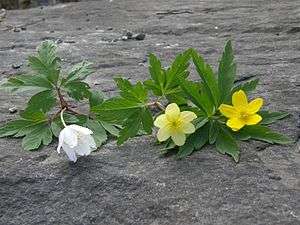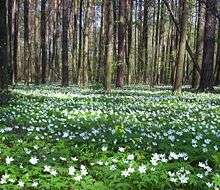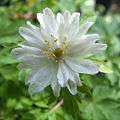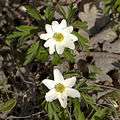Anemone nemorosa
| Anemone nemorosa | |
|---|---|
| | |
| Scientific classification | |
| Kingdom: | Plantae |
| (unranked): | Angiosperms |
| (unranked): | Eudicots |
| Order: | Ranunculales |
| Family: | Ranunculaceae |
| Genus: | Anemone |
| Species: | A. nemorosa |
| Binomial name | |
| Anemone nemorosa L. | |
 | |
| Wikimedia Commons has media related to Anemone nemorosa. |
Anemone nemorosa is an early-spring flowering plant in the genus Anemone in the family Ranunculaceae, native to Europe. Common names include wood anemone, windflower, thimbleweed, and smell fox, an allusion to the musky smell of the leaves. It is a perennial herbaceous plant growing 5–15 centimetres (2–6 in) tall.
Biology
The plants start blooming soon after the foliage emerges from the ground. The leaves are divided into three segments and the flowers, produced on short stems, are held above the foliage with one flower per stem. They grow from underground root-like stems called rhizomes and the foliage dies back down by mid summer (summer dormant). The rhizomes spread just below the soil surface, forming long spreading clumps that grow quickly, contributing to its rapid spread in woodland conditions, where they often carpet large areas.
The flower is 2 centimetres (0.8 in) diameter, with six or seven (and on rare occasions eight to ten) tepals (petal-like segments) with many stamens. In the wild the flowers are usually white but may be pinkish, lilac or blue, and often have a darker tint on the backs of the tepals. The flowers are pollinated by insects, especially hoverflies.[1]
Grown from seed the plants take around five years to flower. [2]
The yellow wood anemone (Anemone ranunculoides) is a similar plant with slightly smaller, yellow flowers.
Medicinal uses
The plant contains poisonous chemicals that are toxic to animals including humans, but it has also been used as a medicine. All parts of the plant contain protoanemonin, which can cause severe skin and gastrointestinal irritation, bitter taste and burning in the mouth and throat, mouth ulcers, nausea, vomiting, diarrhea, and hematemesis.[3]
Cultivation
Anemone nemorosa is grown as an ornamental plant for use in gardens and parks.
- Cultivars
Many cultivars have been selected for garden use, such as Anemone nemorosa 'Allenii' which has large blue flowers. It has been awarded an Award of Garden Merit (AGM) H4 (hardy throughout the British Isles) by the Royal Horticultural Society, as have several of its cultivars (see below).
The RHS Plant Finder 2008–2009 lists 70 cultivars of Anemone nemorosa (AGM H4) available from nurseries in the UK. Some of those most widely available are:

- 'Alba Plena' - double white
- 'Allenii' (AGM H4) - large lavender-blue flowers, often with seven petals (named after James Allen, nurseryman)
- 'Bowles' Purple' - purple flowers (named after E.A. Bowles, plantsman and garden writer)
- 'Bracteata Pleniflora' - double, white flowers, with green streaks and a frilly ruff of bracts
- 'Robinsoniana' (AGM H4) - pale lavender-blue flowers (named after William Robinson, plantsman and garden writer)
- 'Royal Blue' - deep blue flowers with purple backs
- 'Vestal' (AGM H4) - white, anemone-centred flowers
- 'Virescens' (AGM H4) - flowers mutated into small conical clusters of leaves.
Anemone × lipsiensis, a hybrid between A. nemorosa and A. ranunculoides, has pale yellow flowers; A. × lipsiensis 'Pallida' is the best-known result of this cross. It has been awarded the AGM H4, like both of its parents.
Gallery
-

Form
-

Colonial growth
-

Double-flowered cultivar
-

Pink-flowered plant in Germany
-

Blue-flowered plant in Nashville
-

Flowers with six, seven, eight and nine tepals
-

Flower with ten tepals
References
- ↑ Blank, S. and M. Wulf. Investigations on seed production and pollinator biology of Anemone nemorosa (Buschwindröschen). Leibniz-Centre for Agricultural Landscape Research (ZALF). 2008.
- ↑ Colonization of secondary woodlands by Anemone nemomsa Jbrg Brunet and Goddert von Oheimb - Nodic Journal of Botany
- ↑ Symptoms of Plant poisoning - Protoanemonin. RightDiagnosis.com
Further reading
- Shirreffs, D. A. 1985. Anemone nemorosa L. Journal of Ecology 73: 1005-1020.
- Philip, C. Plant Finder 2008-2009. ISBN 978-1-4053-3190-6.